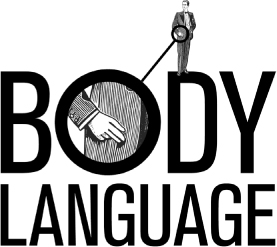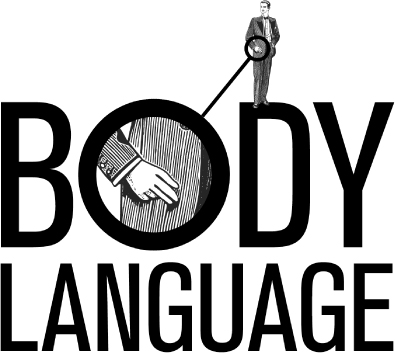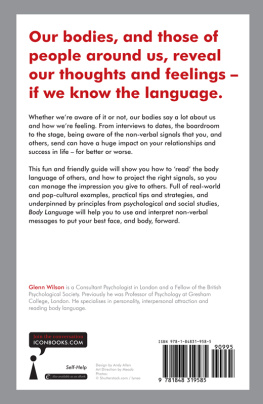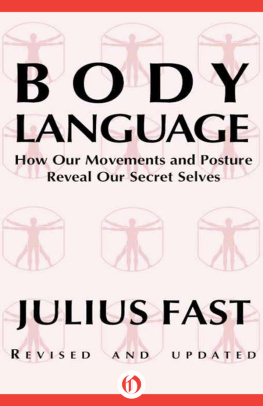

The signals you dont know youre sending, and how to master them
GLENN WILSON

Published in the UK in 2016
by Icon Books Ltd, Omnibus Business Centre,
3941 North Road, London N7 9DP
email:
www.iconbooks.com
First published in the UK in 2012 by Icon Books Ltd
Sold in the UK, Europe and Asia
by Faber & Faber Ltd, Bloomsbury House,
7477 Great Russell Street,
London WC1B 3DA or their agents
Distributed in the UK, Europe and Asia
by TBS Ltd, TBS Distribution Centre, Colchester Road,
Frating Green, Colchester CO7 7DW
Distributed in Australia and New Zealand
by Allen & Unwin Pty Ltd,
PO Box 8500, 83 Alexander Street,
Crows Nest, NSW 2065
Distributed in South Africa
by Jonathan Ball, Office B4, The District,
41 Sir Lowry Road, Woodstock 7925
Distributed in India by Penguin Books India,
7th Floor, Infinity Tower C, DLF Cyber City,
Gurgaon 122002, Haryana
Distributed in Canada by Publishers Group Canada,
76 Stafford Street, Unit 300
Toronto, Ontario M6J 2S1
Distributed in the USA
by Publishers Group West,
1700 Fourth Street,
Berkeley, CA 94710
ISBN: 978-184831-958-5
Text copyright 2012 Glenn Wilson
The author has asserted his moral rights
No part of this book may be reproduced in any form, or by any means, without prior permission in writing from the publisher.
Typeset in Adobe Caslon by Marie Doherty
Printed and bound in the UK by Clays Ltd, St Ives plc
About the author
Dr Glenn Wilson is a Consultant Psychologist in London and a Fellow of the British Psychological Society. Previously he was a Visiting Professor of Psychology at Gresham College, London and a Professor at the University of Nevada, Reno. He specialises in personality, interpersonal attraction and reading body language.
CHAPTER 1
Everybodys second language
Fie, fie upon her!
Theres language in her eye, her cheek, her lip.
Nay, her foot speaks: her wanton spirits look out
At every joint and motive of her body.
Ulysses, in Shakespeares Troilus and Cressida
I speak two languages Body and English.
Mae West
There are many jokes about dogs that talk. They are funny because we know that dogs dont talk. Or do they? Dog owners know that Fido can express himself quite effectively in a variety of ways. He can wag his tail and bark excitedly when anticipating food or walkies. He can lower his head and cower as though expecting to be hit when feeling guilty about stealing some sausages. These emotions are readily understood by dog owners. Fido can also glean a great deal about how we are disposed towards him from our gestures and behaviour. Although he might be responsive to the shape of certain words, such as his own name, most of this communication is through the reading of body language and tone of voice.
Humans dont have to rely on such indirect signals because we have an advanced language capability and can state our case much more clearly and explicitly. At least we think we can.
REMEMBER
All of the emotional signalling that animals use is still present in humans and registers importantly with us. After all, we cannot always trust what someone tells us: they may have reasons for wanting to be deceptive. Some things, like cold facts and statistics, are best communicated by words and numbers but attitudes and intentions are better read through body language.
In some ways, body language is even more highly developed in humans because we have a most expressive face that has developed in connection with our preferred front-on interaction. Powerful signals are transmitted by facial expressions. We also have a highly developed capacity for mind-reading. This is the very useful capacity to second-guess what somebody has in mind for us based on voice inflexions and body language cues. Obviously it is important to know whether or not someone fancies us or wishes we would just go away. It is important to know whether they are on-side or on the verge of attack. Mind-reading ability has been retained and in some ways further evolved in humans because it has considerable survival value.
Where there is a discrepancy between what is said verbally and the feelings that are indirectly transmitted through facial expression and body language, we quite rightly set greater store by what we see, rather than what we are being told. This is because body language leaks certain emotions and attitudes that we might have preferred to conceal from those who observe us (and they know it). The reception process is immediate and largely unconscious, though it can be made conscious through a process of analysis such as that used in this book.
It is widely said that 93% of our communication is through body language, while only 7% is based in the words themselves. Although Albert Mehrabian, the researcher on whose work in the 1960s this assertion is based, has said this is a simplification of his findings, others have produced data suggesting that around 6070% of our communication is non-verbal.
case study
Studies of US presidential election campaigns have been done in which the speeches of candidates are assessed through watching videos with and without sound, listening to sound recordings alone and simply reading transcripts. This allows comparison of the power of the various channels to influence voter choices and it confirms that visual body language, and even tone of voice, are much more persuasive than the verbal content of the message. Not surprisingly a new breed of spin doctors, image consultants and television coaches has grown in strength.
It is now widely recognised that what we often think of as our second language is actually of more importance than our first. Any poker player, salesperson, investigating detective, actor or nightclub dancer will attest to this, so it is important to study it and understand its principles.
try it now SEEN AND NOT HEARD
Next time you are at a noisy cocktail party or social function where you can barely hear the person you are talking to, take a look at groups of people interacting across the other side of the room. Even though you cannot hear a word they say, you will be able to divine a great deal about what is really going on between them and their true feelings and intentions towards each other. Perhaps one is making a play for the other that you can tell is unwelcome and will come to nothing. One may be clearly dominant over the others because the others are all respectful and attentive towards that individual. In a funny way, you can often tell more about the real relationships among people when you are not distracted by the content of the small talk that is going on between them.
But how can you ever know if you were right? The same effect can be achieved by turning off the sound on the TV when a drama or soap is playing. An amusing party game is to supply some of the dialogue that you cannot hear on a video, then afterwards replay it with the sound up to see how far wide of the mark you were. At the very least, you will probably have been right about which characters were at loggerheads and which were enjoying warm rapport. If you were wrong, was it bad acting, or was there some additional agenda or undercurrent that might explain why the words were inconsistent with the body language?
Next page














